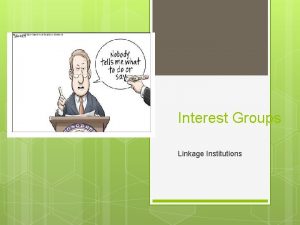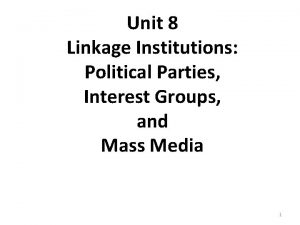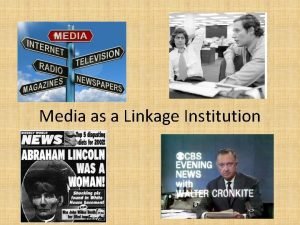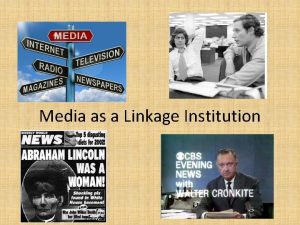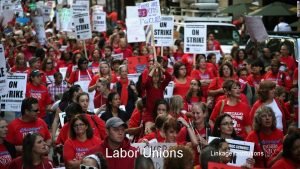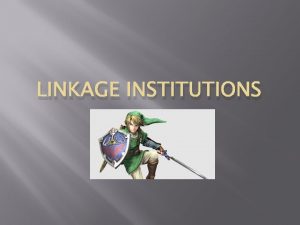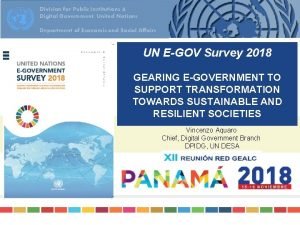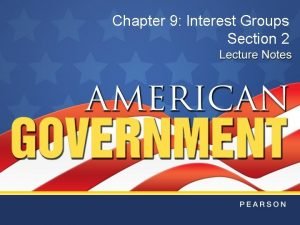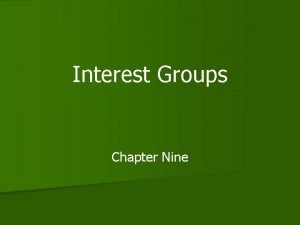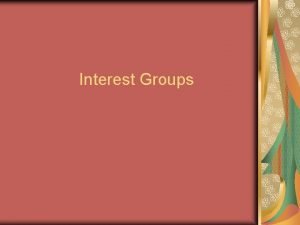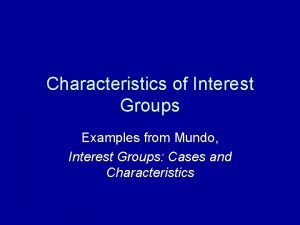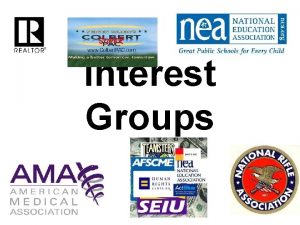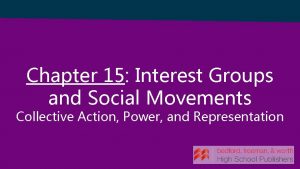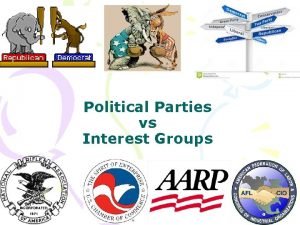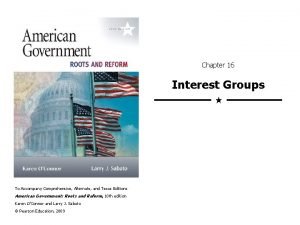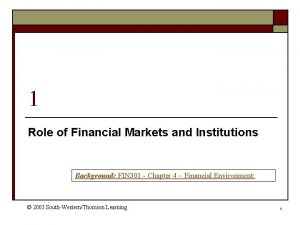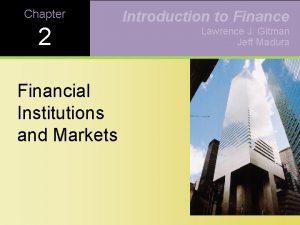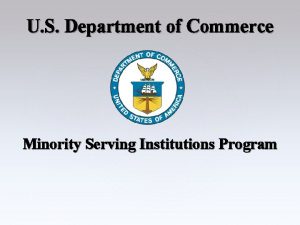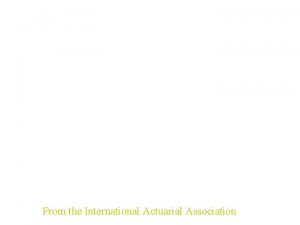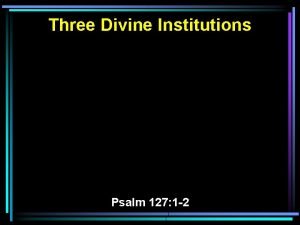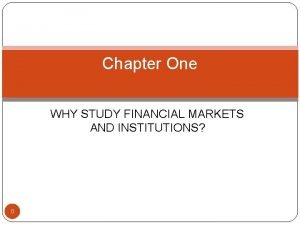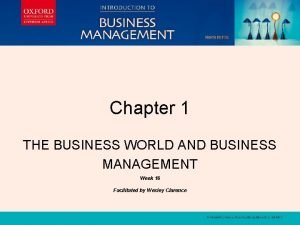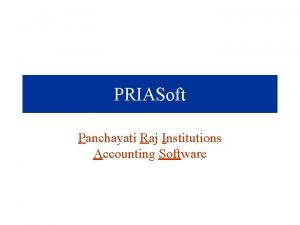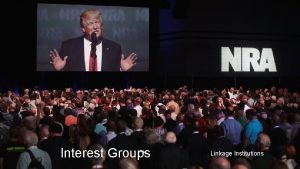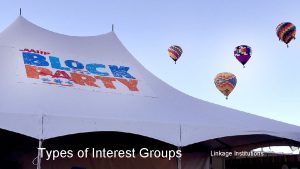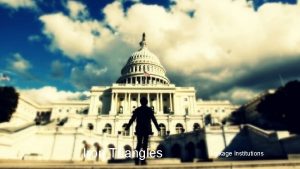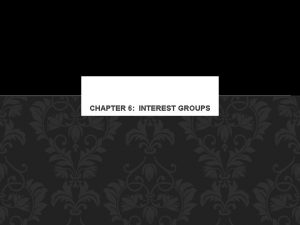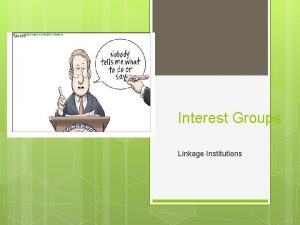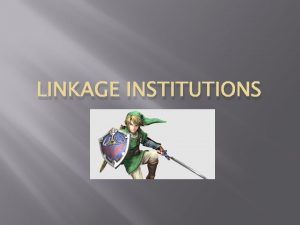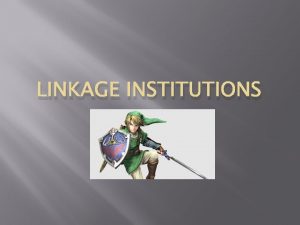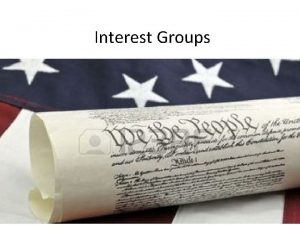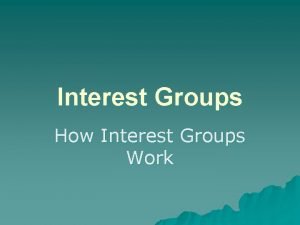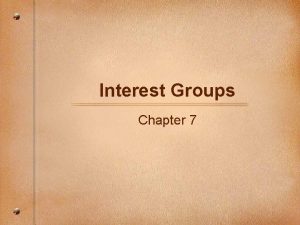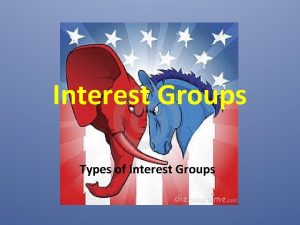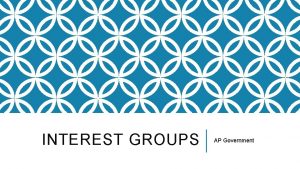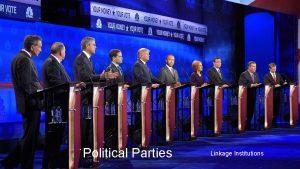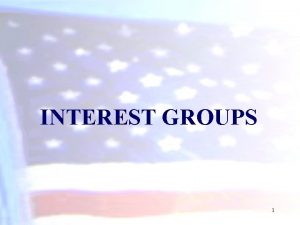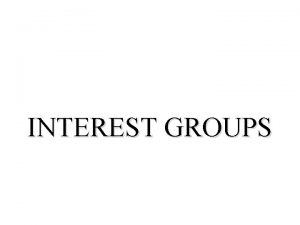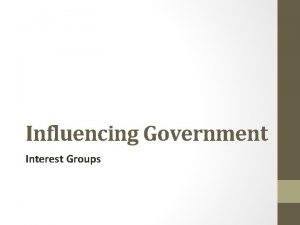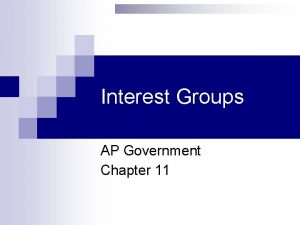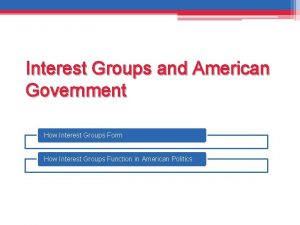Interest Groups AP Government Linkage Institutions n Linkage






































- Slides: 38

Interest Groups AP Government

Linkage Institutions n Linkage institution: means by which individuals can express preferences regarding development of public policy n Four main linkage institutions – Interest Groups – Elections – Political parties – Media n Viewed as the input agents that result in output (policy) for policy-making institutions

n Definition of interest group: – Organized group of individuals – Share common interest, attitude, or goal – Seek to influence govt & political process to achieve goals (target all branches at all levels) n Founders wary of factions [IGs] – Fed 10 – Many provisions of Constitution aimed at limiting “mischiefs of faction” n Const. encourages competition btwn factions – “ambition to counter ambition”

Interest Groups in America is considered pluralistic – many different groups seeking to secure its members interests n Work outside of the political system, (separate and independent from the actual government structure) n Serve as policy specialists not generalists

Theories of Interest Group Politics n Pluralism – Many different groups seeking to secure its members interests. – Public policies emerge from bargaining and compromises among competing groups. – Sep. of powers in gov’t allows many different points of access/influence – so no one group can dominate. – If an interest group lacks $, their size and intensity can be used to achieve goals.

Theories of Interest Group Politics n Elitism/Power Elite – Small # of rich individuals, powerful corporate interest groups, and large financial institutions dominate key policy areas. § Ex: recent bailouts – ordinary Americans got small stimulus checks; Wall Street Banks got huge federal bailouts.

Theories of Interest Group Politics n Hyperpluralism – Too many interest groups try to influence public policy. – When political leaders try to please so many competing gropus, often times policies are confusing and contradictory.


CHARACTERISTICS of Interest Groups n Forms and features of the group – Geographic distribution, cohesion, intensity, prestige n Membership – Direct payment of dues, no personal criteria n Organization – Access to funds and officials – Board of Directors § Appointment by members, speak for group, legally responsible for group – Staff Members § Lobbying, Fundraising, Research, Member Recruitment

Where does all the power come from?

Sources of IG Power & Success Size: n Smaller groups have organizational benefits over larger groups – Better chance of having “actual” group members n Larger groups encounter free-rider problem b/c they fight for collective goods – Some attempt to compensate by providing selective benefits to active members


Sources of IG Power & Success Intensity of commitment to issue: n Adv. applies to both large & small groups n Politicians more likely to listen to group that is active/committed to an issue – Ex: single-issue group (ex: abortion) Cohesiveness: membership & organization n Leaders; n Formal activists; members in name only organization vs. loose federations

Sources of IG Power & Success Financial resources: n $$ increases IGs’ access to policymakers – Most groups have PACs to donate $ with hope of influencing policy outcome n But $ doesn’t buy a “win” on policy issue – Ex: ’ 96 Tax Reform Act

Interest Groups in Politics n The closer the ties to political issues, personalities and organizations, the more effective the group n Contributions of Interest Groups – provide link to gov't – provide info – encourage participation – stabilize other groups

Goal: Influence Politics n n n Assist in election campaigns Influence judicial appointments Form PACs File amicus curiae briefs and lawsuits Grassroots work (advertise opinion, letter writing, social protests) – A form of pressure-group activity that attempts to involve individuals who contact their representatives directly in an effort to influence policy – Persuading ordinary voters to act as the group’s advocates

Goal: Form Political Action Committees (PACs) n Organizations, formally independent of candidates themselves – channel money from interest groups to political candidates sympathetic to their groups' policy preferences Electioneering experts who aid candidates financially with member support n Blossomed as a result of FECA of 1974 n Buckley v. Valeo created the “PAC man” n Most money goes to incumbents n


Goal: Lobbying n An attempt to influence the shape of legislation coming out of Congress and other rule making bodies – The activities of a group or organization that seeks to influence legislation and persuade political leaders to support the group’s position

Goal: Lobbying n Employs more than 80, 000 in Washington DC alone n Named from days when Congress didn't live in Washington and stayed in boarding homes or hotels where lobbies were only place to catch and attempt to sway to your side n 23 ways for lobbyists and organizations to lobby on the state and national level § Most often they: testify at legislative hearings, contact government officials directly, help draft legislation


Lobbying Congress n Members of Congress are targets of lobbyists n Many lobbyists are former members n Lobbyists work closely with those members who share their interests n The effectiveness of a lobbyist depends on their reputation for fair play and accurate information


Reform Attempts Federal Regulation of Lobbying Act, 1946 n Lobbying Disclosure Act, 1995 n – Employs a strict definition of lobbyist – Requires lobbyists to: § Register with the clerk of the House and the secretary of the Senate § Report their clients and issues and the agency or house they lobbied § Estimate the amount they are paid by each client – Makes it easier for watchdog groups to track the lobbying activity

Lobbying the Executive Branch n Has expanded As the scope of federal government has expanded – Many potential access points – Lobbyists seek influence at policy formation and implementation stages. – An especially strong link exists between interest groups and regulatory agencies – Groups often monitor the implementation of the laws or policies they advocated.

Lobbying the Judicial Branch n Can take two forms: – Direct sponsorship – Filing amicus curiae briefs § Brief that informs the court of the group’s policy preferences, generally in guise of legal arguments n Interest groups also attempt to influence who is nominated and placed on the bench.

Types of Interest Groups I. Economic II. Ideological or Single-Issue III. Public Interest IV. Foreign Policy V. NGOs VI. Equality VII. Environmental

Types of Interest Groups n I. Economic – establish standards, better working conditions § Determined by the way people earn a living § Business & professional, labor, agricultural n NAM (National Association of Manufacturers) n American Bankers Association n AFL-CIO n General Motors n AMA (American Medical Association) n ABA (American Bar Association) n National Grange n NEA (National Education Association)


Types of Interest Groups II. Ideological or Single-Issue: n Want gov’t policy consistent with their view, often unwilling to compromise n Often strongly liberal or conservative; occasional centrist group n Ex: Nat’l Right to Life; ACLU; NRA; anti-war groups

Types of Interest Groups III. Public Interest: advocate interests of overall community n Claim to work on broad issues on behalf of all citizens/the public good – Ex: Common Cause, Public Citizen, religious groups, etc n Many are consumer groups – PIRGs (Nader orgs): report on gov’t & corp. action relating to consumer interests

Types of Interest Groups IV. Foreign Policy: influence some area of international affairs – Ex: Council on Foreign Relations, AIPAC V. NGOs (non-governmental organizations) = nonprofit groups outside gov’t, often pursue policy goals & lobby regarding foreign affairs issues – Ex: Greenpeace, Amnesty International

Types of Interest Groups VI. Equality: main policy goal = equal rights in housing, employment, education, etc n Often represents minorities & women – Ex: NAACP; NOW VI. Environmental n Control pollution, combat global warming, protect wilderness, species preservation – Ex: Sierra Club; Environmental Defense Fund Other IGs: veterans’ groups, nationality groups


Problems with Interest Groups n Overrepresentation class of views of privileged

n Utilization of free-rider concept of representation – Benefits go to all in an industry, not just group members Benefits that go to members only (better health care, etc. ) n Reliability of funding sources and sponsorship n Could be double influence (corporations, foundations, etc. ) n

Business Role in Interest Groups n Most large corporations – Have their own governmental affairs department – Employ D. C. -based lobbyists to keep them apprised of legislation – Have given substantial soft money in the past – Still use PACS & 527 s which means they still contribute a great deal of money

Helpful videos n Buckley v. Valeo – https: //www. youtube. com/watch? v=d. Jqjq. B 9 m. Tyo n Interest Groups (Cram for the Exam) – https: //www. youtube. com/watch? v=o. De. Buh. I Qd. Yk
 Interest groups linkage institutions
Interest groups linkage institutions Are interest groups linkage institutions
Are interest groups linkage institutions Linkage institution definition
Linkage institution definition Linkage institutions examples
Linkage institutions examples Linkage institution media
Linkage institution media Interest groups
Interest groups Definition of linkage institutions
Definition of linkage institutions Linkage institutions
Linkage institutions Difference between linking loader and linkage editor
Difference between linking loader and linkage editor Individuals groups and institutions
Individuals groups and institutions Division for public institutions and digital government
Division for public institutions and digital government How are ethnic groups and religious groups related
How are ethnic groups and religious groups related Chapter 9 section 2 types of interest groups
Chapter 9 section 2 types of interest groups The nature of interest groups
The nature of interest groups Proliferation of interest groups
Proliferation of interest groups Federalist 10 interest groups
Federalist 10 interest groups State two characteristics of interest groups
State two characteristics of interest groups For or against
For or against What are interest groups
What are interest groups Interest groups vs social movements
Interest groups vs social movements Fundamental goal of interest groups
Fundamental goal of interest groups Free rider interest group
Free rider interest group A virtue of interest groups is that
A virtue of interest groups is that Real vs nominal interest rate
Real vs nominal interest rate Types of interest rate
Types of interest rate Compound interest meaning
Compound interest meaning National powers
National powers Equity securities
Equity securities Formal institutions examples
Formal institutions examples Madura j. financial markets and institutions
Madura j. financial markets and institutions Minority serving institutions definition
Minority serving institutions definition Media institutions
Media institutions Enterprise risk management for financial institutions
Enterprise risk management for financial institutions What are the three divine institutions of god
What are the three divine institutions of god Why study financial markets and institutions
Why study financial markets and institutions The need-satisfying institutions of the market economy
The need-satisfying institutions of the market economy Gnitc
Gnitc Priya software for panchayati raj
Priya software for panchayati raj Institutions of national importance
Institutions of national importance
